Assayers during the reigns of Philip V and Louis I
by Jorge A. Proctor
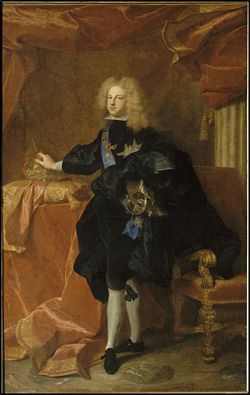 When King Charles II of Spain died on 1 November 1700, childless despite two marriages, the line of the Spanish Royal House of Habsburg, which had ruled since 1516, died with him. Charles died relatively young, shortly before his 39th birthday. Having suffered from a number of disabilities, both physical and psychological, his always fragile health deteriorated even further towards the end of his life. Anticipating his death, Charles drafted a last will and testament on 13 October 1700, where he named a member of the French Royal House of Bourbon, his sister’s grandson, Philip, Duke of Anjou (Philippe, Duc d’Anjou), as his primary successor.
When King Charles II of Spain died on 1 November 1700, childless despite two marriages, the line of the Spanish Royal House of Habsburg, which had ruled since 1516, died with him. Charles died relatively young, shortly before his 39th birthday. Having suffered from a number of disabilities, both physical and psychological, his always fragile health deteriorated even further towards the end of his life. Anticipating his death, Charles drafted a last will and testament on 13 October 1700, where he named a member of the French Royal House of Bourbon, his sister’s grandson, Philip, Duke of Anjou (Philippe, Duc d’Anjou), as his primary successor.
Philip’s lineage within the Spanish throne was not in question. He was the great-grandson of King Philip IV, Charles II’s father. But, as the second son of the current heir apparent to the French throne, the Grand Dauphin (Le Grand Dauphin) Louis, son of King Louis XIV, he was also in the direct line of succession to the French throne. In anticipation of how this could upset the balance of power in Europe, and inevitably lead to war, Charles made special provisions to keep these two monarchies apart, declaring in his last will and testament that: “being Our intention that, in the interests of the peace of Christendom and of all Europe and of the well-being of these Our Realms, this Crown and that of France shall ever remain sundered”Spain under the Bourbons, 1700–1833: A collection of documents. Edited and translated by W. N. Hargreaves-Mawdsley. Published by Macmillan & Co Ltd, London, 1968, p. 1.. As such, it provided that in the event that Philip died before he could take the throne, or chose to “accede to the Throne of France and prefer to wear that Crown rather than that of these Our Realms”ibid., then the Spanish throne would pass to his younger brother Charles, Duke of Berry (Duc de Berry), under the same provisions. Third in line to the throne in this last will and testament was Charles, Archduke of Austria, the second son of Holy Roman Emperor Leopold I, Charles II’s uncleibid. pp. 1-2..
On 12 November 1700, in the Palace of Versailles, King Louis XIV accepts Charles II’s will, and proclaims his grandson Philip as King Philip V of Castile and IV of Catalonia and Aragon. With the news from France, he is also proclaimed King of Spain in Madrid, on 24 November 1700. Quickly, news of the death of Charles II and the ascension to the throne of King Philip V were dispatched to the Americas, where they were received in New Spain by March 1701F. L. Ramos. Succession and Death: Royal Ceremonies in Colonial Puebla, The Americas, Published by: Academy of American Franciscan History, Vol. 60, No. 2 (Oct., 2003), p. 185; Archivo General de Indias (AGI): Guadalajara, 232, L. 9, F. 55v-56r. On 6 March 1701, the officials from Puebla de los Angeles received the royal decree ordering the proclamation of the new Spanish King, Philip V, and 12 days later, the decree ordering the celebration of royal funerary honors for King, Charles II. As for the President of the Audiencia of Guadalajara, he was able to acknowledge receipt of these same orders on 26 March..
The ritual public oath ceremony (jura del rey), mandated to demonstrate loyalty to the new king, was conducted in the main square of the New Spain's cities in April of 1701G. Casasola. 6 Siglos de historia gráfica de México. Tomo 1. Editorial Gustavo Casasola, México 1987. pp. 284. Gustavo Casasola writes: “En la Nueva España, el 2 de abril 1701 se publica el bando anunciando al pueblo y al comercio que durante la celebración de las ceremonias de jura del Rey Felipe V, se adornen las fachadas que cuelguen luminarias por donde deberá pasar el estandarte real, y el que no lo cumpliere, se le multará con diez pesos. El día 4 con motivo de las fiestas de la Encarnación, dieron comienzo los actos preparados: a las diez de la mañana repicaron todas las campanas de todas las iglesias; en el tablado colocado frente a palacio, don Miguel de Cuevas sacó el estandarte y se fue a colocar donde se encontraba el virrey, el arzobispo, la real audiencia, todos los tribunales, los gobernadores con todos sus ministros. En el momento en que fue la proclamación, se soltaron al aire palomas, pájaros, y otras aves, la guardia real disparó sus arcabuces y volvieron a repicar las campanas, a las tres de la tarde se efectuó el desfile por las calles de la ciudad, pero un terrible aguacero, deslució la marcha. Calmada la lluvia se continuó con las ceremonias hasta que el virrey y el arzobispo regresaron a palacio y catedral. Por la noche hubo luminarias y una gran verbena en la plaza mayor.”, for which proclamation medals are known today. But the mint would not start minting coins under the name and coat of arms of the new monarch until 1702Archivo General de la Nación (AGN): Instituciones Coloniales, Real Hacienda, Casa de Moneda (021), Vol. 13, Fojas: 3-11{/foootnote}.
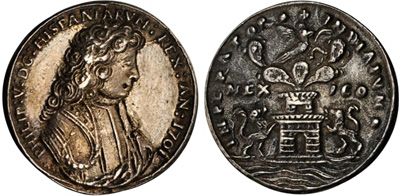
Mexico City, cast and chased silver Proclamation Medal for King Philip V, dated 1701.
(Stack’s Bowers and Ponterio, January 2015 NYINC Auction, lot #1001).
Although Philip of France had been proclaimed King of Spain in accordance with Charles II's will, the Holy Roman Emperor Leopold I, considering himself the rightful heir in accordance with Philip IV's will, refused to accept the will of Charles II from the beginning, pursuing the claim on behalf of his descendants, in order to gain at least part of the Spanish empire. Without war having been declared, in May/June 1701 Emperor Leopold sent Austrian troops commanded by the Imperial General Prince Eugene of Savoy to fight the French in northern Italy. But, when King Louis XIV refused to exclude Philip from the line of succession to the French throne¸ Leopold took advantage of this to organize a coalition against Louis XIV. On 7 September 1701 England, the United Provinces (the Netherlands), and Austria signed a treaty known as the Grand Alliance of The Hague (Treaty of Den Haag). The alliance declared war on Spain and France on 15 May 1702, marking the beginning of what came to be known as the War of Spanish Succession.
Back in Mexico, when the mint started striking coins under Philip V, the working assayer is Manuel de León (assayer mark L). Manuel had been working this post since 1677, when he was appointed by Sebastian Carrillo Maldonado, on behalf of the owners of the post, the Barefoot Carmelite of the Mexican monastery of the Holy Desert of Mount Carmel (El monasterio de Carmelitas Descalzos del Santo Desierto del Monte Carmelo), following the death of Gerónimo Becerra (assayer mark G). Manuel de León continued as the mint’s assayer until 1705. On 23 February of that year his brother, José de León, is brought in as an interim assayer, when Manuel is unable to continue due to an incapacitating illnessAGN: Instituciones Coloniales, Real Hacienda, Casa de Moneda (021), Vol. 6, Exp. 87, Fojas: 253-256.. This José de León should not be confused with José Eustaquio de León, who was his son. José de León had already been working as Manuel’s deputy at the time of his selectionAGI: México, 202, N. 19. José de León is recorded as already serving as deputy of his brother Manuel de León by December of 1697., making for a smooth transition in February. Not many days later, Manuel de León dies. José is promoted to the rank of lieutenant assayer at the mint by the Barefoot Carmelites on 11 March 1705J. de Ordaz. Por los Reverendos Padres Prior y Carmelitas Descalços, Hermitaños de el Santo Decierte de este Reyno, como Dueños de los Officios de Ensayador, y Fundidor Mayor de la Real Casa de Moneda de esta Corte en los autos con Don Joseph de Leon su Theniente, que ha sido en dicho Officios. Con Licencia del Supremo Gobierno en México en Imprenta nueva Plantiniana de Juan Francisco de Ortega y Bonilla, 1721, fol. 1r., and he is ratified on 9 April 1705AGN: Instituciones Coloniales, Real Hacienda, Casa de Moneda (021), Vol. 6, Exp. 89, Fojas: 261v-264v..

Enlarged image of a 1704 Mexican 8 Reales with assayer mark L for Manuel de León.
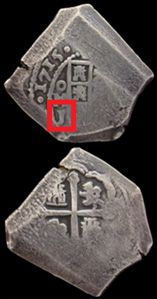
Enlarged image of a 1715 Mexican 8 Reales with assayer mark J for José de León, recovered from the 1715 Fleet.
(Courtesy of The 1715 Fleet Society)
José de León was the assayer in office during the remainder of the War of Spanish Succession, which lasted until 1713, when the Treaties of Utrecht officially put an end to the hostilitiesThe Treaties of Utrecht is the general name given to a series of important treaties signed between 1713 and 1714, which officially ended this conflict.. The Treaties of Utrecht recognized Philip V as the king of Spain. But they transferred the Spanish possessions in the Netherlands and Italy to Austria and Savoy. To ensure that the French and Spanish Monarchies remained separate, the treaties also required that Philip V renounce, for himself and his descendants, any right to the French throne. Various French princes were also required to relinquish any claim, for themselves and their descendants, to the Spanish throne.
In 1715 José de León attempted to appoint his own son, Manuel de León, as his deputyPor el Alferez Don Joseph de Leon Ensayador, y Fvndidor Mayor de la Real Cassa de Moneda de este Reyno, en el Pleyto con el P. Prior, y Comunidad de el Santo Desiertode Carmelitas Descalços, Con Licencia: en México, Por los Herederos de la Viuda de Miguel de Ribera, 1721, fol. 2v, 5th numbered paragraph.. The post of deputy was not one that had been mandated by Spain, but conceived entirely in Mexico. As lieutenant (teniente) of the assayer on record, the deputy was allowed to work the post for this assayer when sick or absent. But, he was not allowed to use his identifying mark on the coins, as guarantee that the fineness in the alloy he prepared, corresponded to that officially ordered. This was in sharp contrast to the Spanish ordinance, which required that the assayer mark placed on the coins, be that of whomever had assayed the metal used on these coinsT. Dasí, Estudio de los Reales de a Ocho (Valencia, España, 1950), Vol. 1, pgs. LV- LXXIX, Document No. 76. “Quaderno de Ordenanças de la lavor de la moneda (1497.– junio 13. – Medina del Campo)”. In the Royal Pragmatic of Medina del Campo, law No. 28, it states: “Lei XXXVIII - Otrosi, porque, si alguna moneda de oro, ó de plata se hallare falta, se sepa qual Ensayador hizo el ensai della, ordenamos i mandamos que cada Ensayador haga poner en cada pieza una señal suya, por donde se conozca quién hizo el ensai de aquella moneda; porque si fuere baxa lei, sepamos á quál Ensayador nos avemos de tornar: i mandamos a los Entalladores de cada una de las dichas Casas que pongan en los cuños la señal, que él Ensayador le señalare por ante el Escrivano de la Casa, para que lo asiente en su libro, i por allí se conozca la señal de que Ensayador es i el que errare sea punido con esta prueba.”. This guarantee, and any possible penalties, continues to rest on the assayer on records, whose mark the deputy continues to use. As such, the deputy is selected by the assayer on record, almost always being a close relative.
The appointment of Manuel de León was rejected by the Barefoot Carmelites due to Manuel’s age at the time. Manuel was said to be under 25 years of age. A working assayer or his deputy had to be 25 years old to hold these posts at the Mexico mintPor el Alferez Don Joseph de Leon… (op. cit., n. 12)..
By 1718 José de León had suffered an accident, when he fell off a ladder at the mint, and ended up as a convalescentPor el Alferez Don Joseph de Leon… (op. cit., n. 12), fol. 1v, 1st numbered paragraph.. This time, rather than just appoint Manuel as a deputy, José decided that it would be best to transfer the office to his son, whom he saw as a good and capable candidate. José went before the head of the Barefoot Carmelite convent, Prior Fray Martín de la Madre de DiosEl Santo Desierto de los Carmelitas de la Provincia de San Alberto de México. Revisión Paleográfica Introducciones y Notas por Dionisio Victoria Moreno y Manuel Arredondo Herrera. Biblioteca Enciclopédica del Estado de México, México, 1978, p. 580. Martín de la Madre de Dios became the Prior of the Carmelite Convent of the Holy Desert in 1713 and remained in office until 1720., to make his wishes known. The Prior immediately set a date for him or his son to return and present José’s formal letter of resignation and the birth certificate of his son Manuel, as evidence that he was now of the required age. But, when that day came and went with no sign of José or his son, Fray Martín de la Madre Dios wasted no time in appointing Don Juan de Cueva, a former assayer from the mines of San Luis de Potosí, to replace José at the mint. But José de León was not about to go quietly! Before Juan de Cueva could be ratified by the Spanish authorities, José quickly filed a lawsuit claiming that there had been a misunderstanding. This action successfully blocked the appointment of Juan de Cueva by the Barefoot CarmelitesPor el Alferez Don Joseph de Leon… (op. cit., n. 12)..
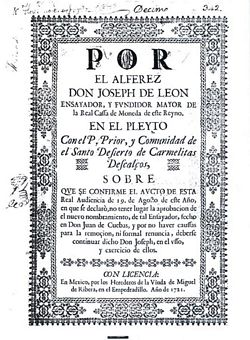

Copies of the front page of the legal arguments during the trial between the Mint Assayer, José de León, and the owners of the office, the Barefoot Carmelite Convent of the Holy Desert (1718-1721). To the left is the front page of José de León’s arguments, while at the right is the front page of the Barefoot Carmelites’
At the end, José de León won his lawsuit and remained in office, despite the Barefoot Carmelites’ desires. During the last years of his tenure José de León employed his son, Manuel de León, and Nicolás de Rojas, as deputiesPor el Real Fisco El Doct. D. Juan Ignacio de la Encina y la Carrera, Cavallero del Orden de Santiago, del Consejo de su Mag. Y su Fiscal en el Real de Hacienda, y de la Junta de Comercio, y Moneda, en la causa que pende en dicha Real Junta contra el Thesorero, Ensayador, y otros Oficiales de la Casa de Moneda de Mexico, sobre faltas en la obligacion de sus oficios– Spain, Circa 1735, p. 5, 9th numbered paragraph and page 6, 12th numbered paragraph. This document, which discusses the coins with assayer mark J being examined during the 1729 mint investigation, states that: “… siendo las de la letra J labradas (segun se dixo) en tiempo que fue Ensayador de la Casa Don Joseph de Leon, y otros, no del mismo nombre…” and “…la letra J (con cuya señal expressaron Don Joseph de Ribas, Don Manuel de Leon, y Don Joseph Eustaquio de Leon) se avian despachado en la Real Casa las Monedas por tres Ensayadores, que el uno fue Don Joseph de Leon, padre de los referidos; otro el mismo Don Manuel de Leon su hijo, y el tercero Don Nicolàs de Roxas, à quien siguiò Joseph de Ribas…”.
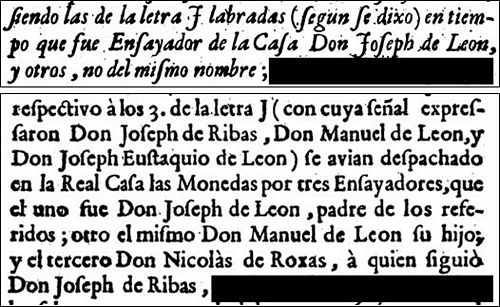
In the 1729 mint investigation it was revealed that the coins with assayer mark J were minted during the time that José de León served as assayer, “and others, not of the same name.” The names of the other assayers who worked as deputies under José de León is further revealed in this document, which states that three assayers were responsible for the coins with assayer mark J, these being: José de León, his son Manuel de León, and Nicolás de Rojas.
As for the Barefoot Carmelites, determined to ensure that a similar situation never happened again, they convinced the Viceroy to allow them to name their lieutenants, without intervention from the Treasurer of the Mint, who until now had been involved in the approval process. The Viceroy agreed, giving the order in 1720AGI: México, 749.. This now allowed for the Barefoot Carmelite monastery of the Holy Desert to take advantage of the deputyship system already in place, and upon completion of José de León’s tenure in 1723, they named themselves as the assayer on record (The D on the coins is for Desierto, in acknowledgement of “El Convento del Santo Desierto del Monte Carmelo”), while appointing José de Rivas Angulo to be responsible for the actual work at the mint, as their deputy{footnote}Las Casas de Moneda de los Reinos de Indias. Vol. 2: “Cecas de Fundación Temprana”. Directed by Anes y Alvarez de Castillón, Gonzalo and Céspedes del Castillo, Guillermo. Chapter titled “La Época de Gestión Delegada, 1535-1732, by Agustín Pineda Aguilar, Madrid, Spain, 1997, p. 70. Although he did not provide an explanation as to how such unusual event could have taken place, Agustín Pineda Aguilar can be credited with being the first to correctly identify the letter D (assayer mark) seen on the coins, as being the initial used for “Desierto”. In his writing from 1997, when discussing the mint investigation conducted in 1729, Agustín Pineda Aguilar writes: “En cuanto a la falta en la ley, cuya imputación tocaba directamente al fundidor y ensayador, se las relacionaba con la entrada y errada fundición de algunas platas que se habían amonedado y cuyos registros evidenciaban la letra D, inicial de ≪Desierto≫, por los carmelitas del Santo Desierto, titulares del oficio.”
Por el Real Fisco… (op. cit., n. 18), p. 5, 9th numbered paragraph. This information is substantiated by this document, which discusses the coins being examined during the 1729 mint investigation. This document states: “…las de la D, de las que se avian fabricado desde que era Ensayador Don Joseph de Ribas, que entro à serlo en principios del año de 23. desde cuyo tiempo ponia esta letra, por ser este oficio del Santo Desierto…” It should be noted that, regarding start of José de Rivas Angulo’s tenure, the year 23 (for 1723) is documented in error in the previous paragraph. This is in fact later corrected in page 11, numbered paragraph 29, of this same document as follows: “…el Ensayador D. Joseph de Ribas Angulo, que entrò à serlo por principios de 24...”.
Since the deputies did not hold the same rights bestowed on the lieutenants, the Barefoot Carmelites must have felt pretty comfortable with their decision. Any problems that arose, they could just replace José de Rivas Angulo, without the fear of another litigation, which they could lose. But, identifying themselves as the assayer on the coins, while someone else did the work, now created a dangerous proposition, as this mark also identified who to hold responsible, if problems were ever found with the weight and fineness on the coins.
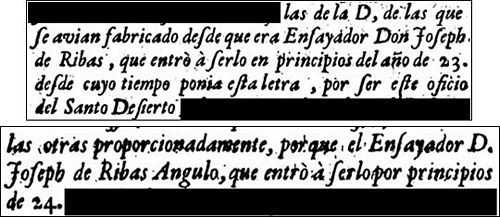
The 1729 mint investigation also revealed that the coins with assayer mark D were minted during the time that José de Rivas Angulo served as assayer, who used this mark in acknowledgement that it belongs to the Holy Desert (“el Santo Desierto”). Although the year when José de León started working as the assayer on record was initially recorded in error as the beginning of 1723 (simply documented as 23), this in fact was later corrected, as can be seen above, to 1724 (again, simply documented as 24).
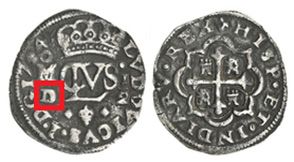
Enlarged image of a 1724 Mexican Half Real “galano” coin with assayer mark D for “el Santo Desierto”, minted under assayer José de Rivas Angulo.
(Daniel Frank Sedwick, LLC, Treasure Auction #18, 29 October 2015, Lot #534.)
In January of 1724, José de Rivas Angulo starts working the post of assayer in the Mexico City mint. At that same time in Spain, King Philip V decides to abdicate the throne in favor of his eldest son, the Prince of Asturias (Principe de Asturias), Louis, so that he could withdraw into solitude, where he could devote the rest of his life to the service of God, in preparation for eternityVoto y Renuncia del Rey Don Felipe V, Discursos Leídos Ante la Real Academia de la Historia en la recepción pública del Excmo. Sr. D. Joaquín Maldonado Macanaz, el día 3 de Mayo de 1894, Madrid, Imprenta y Litografía de los Huérfanos, 1894, pp. 15-16. Although King Philip V’s abdication of the throne came as a surprise to many in Madrid and Europe, he had in fact made a secret pledge (un Voto secreto) with his wife, Queen Elizabeth Farnese, signed on 27 July of 1720 at El Escorial, where they agreed to relinquish this crown by all Saints Day of 1723 (1 November 1723), at the latest; a date which, for unknown reasons, was slightly delayed. This pledge was renewed a total of four times, on: 15 August 1720 at El Escorial, 27 August 1721 at El Escorial, 15 August 1722 at El Escorial and 15 August 1723 at Valsaín. The initial pledge, although written in French, has been translated and published in Spanish, and it states: “Nos prometemos mutuamente renunciar la Corona y retirarnos del mundo, para pensar sólo en nuestra salvación y en servir á Dios, infaliblemente antes del día de los Santos del año de 1723, á más tardar. Escorial 27 de julio de 1720.—Felipe—Isabel.”.
Philip V advised the Council of Castile of his intend to abdicate the throne to his 16-year-old son, Louis, by Royal Decree signed on 10 January 1724Voto y Renuncia del Rey Don Felipe V… (ibid, n. 21), p. 13. The Royal Decree abdicating the throne, signed by King Philip V on 10 January 1724, states: “Habiendo considerado de cuatro años á esta parte con alguna particular reflexión y madurez las miserias de esta vida, por las enfermedades, guerras y turbulencias que Dios ha sido servido enviarme en los veinte y tres años de mi reinado, y considerando también que mi hijo primogénito Don Luis, Príncipe jurado de España, se halla en edad suficiente, ya casado y con capacidad, juicio y prendas bastantes para regir y gobernar con acierto y justicia esta Monarquía, he deliberado apartarme absolutamente del gobierno y manejo de ella, renunciándola con todos sus Estados, Reinos y Señoríos en el Príncipe Don Luis, mi hijo primogénito, y retirarme con la Reina, en quien he hallado un pronto ánimo y voluntad á acompañarme gustosa á este Palacio y Retiro de San Ildefonso, para servir á Dios, y desembarazado de estos cuidados pensar en la muerte y solicitar mi salud. Lo participo al Consejo, para que en su vista avise donde con venga y llegue á noticia de todos. En San Ildefonso á 10 de Enero de 1724.”. Prince Louis was made aware of the abdication of the throne on him by a letter written from San Ildefonso by his father, King Philip V, on 14 JanuaryP. Nolasco Blanco y M. Diez. Examen Histórico-Filosófico de la Legislación Española, Tomo I, Madrid, Imprenta de Don Marcos Bueno, 1845, pp. 313-316. This book includes a complete transcribed copy of this important letter.. On 15 January, Louis, who was the same age as his father had been when he ascended to the throne of Spain in 1700, from San Lorenzo el Real, accepts the crown and is proclaimed King Louis I of Spain on 9 February 1724J. Ortega Rubio. Historia de España, Tomo V. Madrid, Librería Editorial, 1908, pp. 31- 32.
As it was customary, once Louis I was proclaimed King in Spain, the news, in the form of Royal decrees, were quickly dispatched to the Americas, so that the ritual public oath ceremony for the proclamation of the new king could also be conducted there. On 25 July of 1724, this ceremony was conducted in MexicoM. Soto. El Arte Maestra: Un tratado de pintura novohispano. Universidad Nacional Autónoma de México, Instituto de Investigaciones Bibliográficas, Mexico, 2005, p. 90. The date of the proclamation of Louis I in Mexico is known from the title of a book printed in Mexico in 1724 by the Publisher (Impresor Mayor de la ciudad de México) Joseph Bernardo de Hogal, Titled: Breve Explicacion de lo que contiene la pyramide, que para celebrar la Jura de nueftro Catholico Monarcha Luis Primero, (que Dios Guarde), ofrecieron los profeffesores del Nobiliffimo Arte de la Pintura, en la Ciudad de Mexico, el dia 25 de Julio del Año de 1724. No copies of this book are known today., at which time the Latin name of the king was changed on the coinage from that of “PHILIPPVS V” to “LUDOVICUS I”.
Louis I’s reign would not be marked by any memorable events, as it would be of short duration. The young king died in Madrid between the hours of two and three in the morning on 31 August 1724, after contracting smallpoxSpain under the Bourbons (op. cit., n. 1), p. 85.; he had just turned seventeen on 25 August. The death of Louis opened the door for the return of Philip V to the throne. But, despite him being named in Louis last will and testament, this was not an automatic proposition. Not only did Philip lack interest to return to the throne, but the Council of Castile, unsure of the legality of a king’s return after abdication, also needed to conduct deliberations. At the end, under advise of the Papal nuncio in Madrid, Alessandro Aldobrandini, and in agreement with the final report of the Council of Castile, on 6 September 1724 Philip agreed to return to the throneFénelon in the Enlightenment: Traditions, Adaptations, and Variations, Edited by C. Schmitt-Maaß, S. Stockhorst and D. Ahn (Amsterdam – New York, 2014), Section titled, “Prendre mòdele sur Télémaque: The Fénelonian Underpinnings of ‘Cultural Policy’ at the Court of Philip V of Spain” by Jorge Férnandez, Santos Ortiz-Iribas and Sara Muniain Ederra, p. 139., for which he was restored the following dayEulogio Fernández Carrasco, “Felipe V. Abdicación y restauración de la Corona Española y sus efectos jurídicos”, GLOSSAE. European Journal of Legal History 12 (Valencia, Spain, 2015). pp. 304-305..
Soon after decrees were drafted and dispatched to the Indies, announcing the death of Louis I, and the return of Philip V to the Throne, asking that they “exercise restraint, excusing all those expenses that are not very necessary”Santiago Sebastián López. Arte Funerario y Astrología: La Pira de Luis I, Ars Longa, Revista del Departament d’Història de l’Art de la Universitat de València, No. 2, 1991, p. 113. Regarding the Royal decree, the autor writes: “…ordenaba en una real cédula que se organizase el luto, pero recordaba que en lo tocante a túmulos ‘se moderen, escusando todos aquellos gastos que no sean muy precisos’”.. These decrees ensured that Spain’s overseas possessions carry out the mandatory symbolic rituals known as exequias reales: Royal funerary honors, performed in order to commemorate the death of the ruler, and celebrate the transfer of secular loyalty and power to the next king.
With the slow communication between Spain and the Indies, Mexico would not learn of the death of Louis I until 1725, first learning of it, unofficially, through a vessel that arrived in January from CaracasLópez (ibid. n. 29).. The official notification arrived in the port city of Veracruz in February, from where it was finally delivered to the city of Mexico on 28 March 1725, where the funerary ceremonies beganI. Osorio Romero. El sueño criollo: José Antonio de Villerías y Roelas (1695-1728). Universidad Nacional Autónoma de México, Instituto de Investigaciones Filológicas, Mexico, 1991, p. 45..
Although the exact date when the mint of Mexico began replacing the name of Louis I for that of Philip V on the coins is not currently known, this probably occurred fairly quickly, just as it had been done in 1724. Due to the imperfect striking of these coins, which leave much of the design off the coin’s planchet, a standard at the time, the King’s name is not visible, or not visible enough, in almost all the few known Mexican coins from this year to establish how many coins are known for each monarch. But we do know that the change did occur in this year, as this is further corroborated by some of the known 1725 Mexican special production coins, nowadays known as “galanos”, for which the King’s name is clearly shown as “PHILIPPVS V”J. L. Lázaro. Reales de a Ocho: Los REDONDOS de Lima, Méjico y Potosí y otras acuñaciones especiales. Madrid, 1996, p. 132 (Philip V 1725 Mexico 8 Reales); Numismatic Collection of the Bank of Mexico, Inventory Numbers 702 and 703 (Philip V 1725 Mexico Half Reales)..
José de Rivas Angulo continued working the post of assayer at the mint, using the letter D for Desierto, as he had been doing since 1724, and in 1727 he was even allowed to have his own deputy, for which his brother, Diego González de la Cueva is assignedCentro de Estudios de Historia de México, Archivo de Manuscritos de la Colección Román Beltrán, Fondo VIII-4, Carpeta: 4, Legajo: 137. When the Barefoot Carmelites were asked in 1730 to name a new assayer, Fray José de los Angeles provided the name of Diego González de la Cueva, since, as he responded: “Que su convento del Santo Desierto, desde el año de 1727 tenía nombrado a Don Diego Gonzalez de la Cueva, para las ausencias y enfermedades de don Jose de Ribas.”
Por el Real Fisco… (op. cit., n. 18), p. 12, 30th numbered paragraph (this paragraph starts on the previous page). The fact that these two officials were brothers is recorded in the 1729 mint investigation, being documented as: “…sucediò varias vezes que à su instancia Don Joseph de Ribas, y su hermano Don Diego González de la Cueba, ensayaron el grano, ò fragmento, que quisieron tomar de la Cizalla…”. But, soon after, discrepancies on the required fineness of the Mexican coins were found after repeated assays conducted in Spain by orders of the King. At this same time, problems were also being reported with the overall weight of the Mexican coins, as well as those from Potosí}Los Códigos Españoles Concordados y Anotados: Nueva Recopilación. –Autos Acordados. Ordenanzas de Bilbao. Tomo 12. Madrid, 1851, pp. 265-276. Ordenanzas para las Casas de Moneda de estos Reinos, i los de las Indias – Madrid á 9. de Junio de 1728; AGI (op. cit., n. 19). Decree from King Philip V dated in Madrid on 5 August 1728, remitted to the Viceroy in Mexico. Determined to solve these problems, the King passed a new monetary reform on June 9, 1728Los Códigos Españoles… (ibid. n. 34).. With the justification of standardization between the fineness of the Spanish coins and those of other European nations, this new Royal Ordinance, among other things, would now lower the fineness in the Mexican coins, from 11 dineros and 4 grains (930.5 fine) to 11 dineros (916.6 fine) and produce the coins at a rate of 68 reales per mark of silver, vice the 67 reales previously worked. This order also instructed the mechanization of the coin-striking process in all the Spanish mints, in Spain and the Indies, replacing with new machines: rolling-mills and screw presses, the manufacturing techniques of cutting coin blanks with scissors and striking the coins with hammers between two dies. The new machines would now produce perfectly round machine-struck coins with a milled edge design (“de figura circular con cordoncillo al canto”), a milled coinage, which would now serve to discourage the illegal practices of debasing coins by clippingClipping: shaving or cutting small pieces of metal from the coin’s circumference, which was specially made possible by the imperfect technique of flan preparation during the hammered struck coinage, which irregular coin blanks were normally obtained by cutting up hammered sheets of metal with shears. and sweatingSweating: dropping a number of coins in a bag, and then shaking it violently thus, by friction, leaving tiny amounts of metal onto the inside of the bag’s surface. The metal scrap left on the inside of the bag would then be collected by burning the bag. Provided that these coins were not later weight, they would retain the appearance of not having been tampered with..
The design for the new milled coinage was revealed for the first time by a separate decree dated 8 September 1728. This design, on one side, consisted of the Bourbon shield of King Philip V with the inscription PHILIPPVS V. D. G.D. G.: abbreviation for DEO GRATIA (by the grace of God) HISPANIARVM ET INDIARVM REX (Philip V, by the grace of God, king of Spain and the Indies), further abbreviated where needed, and on the other side, both hemispheres of earth (referred to as “two worlds”) crowned, placed above waves and between two crowned pillars (representing the Pillars of Hercules), with each pillar containing a banner with a portion of the motto PLVS VLTRA (meaning more beyond), and the inscription above: VTRAQUE VNUM (meaning both are one)Los Códigos Españoles… (op. cit., n. 34), p. 278. “Madrid á 8. de Septiembre de 1728. “…Que la plata nueva, que he mandado labrar en Indias, i la que se labrare en estos Reinos con el cuño de mis Reales Armas de Castillos, i Leones, i en medio el escudo pequeño de las flores de Lis, i una granada al pie con la inscripcion Philippus V. D. G. Hispaniarum, et Indiarum Rex, i por el reverso las dos columnas coronadas con el Plus ultra, bañandolas unas ondas de mar, i entre ellas dos mundos unidos con una corona, que los ciñe, i por inscripcion utraque unum…”.
At the end of 1728 the Mexican Viceroy Juan de Acuña, the Marquis of Casafuerte, confirmed receipt of the new monetary orders. It is likely that it was at this time that he also received a separate decree written on 30 June 1728Las Casas de Moneda… (op. cit., n. 20)., asking that he conduct an investigation of the mint officials and their involvement in the loss of weight and fineness on the Mexican coins.
On 30 December the Viceroy ordered that on 1 January 1729 part of the new monetary plan be put in motion, ordering that the fineness in the current coins be lowered as decreed, changing the rate of production of the coins, as well, to the new rate of 68 reales per mark of silverLas Casas de Moneda… (op. cit., n. 20), p. 66.. By 15 January 1729Las Casas de Moneda… (op. cit., n. 20), p. 67. the Viceroy was able to inform Spain that the changes ordered on 30 December of 1728 had in fact been implemented, also informing that he had appointed as Superintendent of the Mint the OidorOidor: Title given to a royal judge appointed to serve as a member of one of the judicial tribunals known as Audiencias. Unlike in Spain, where the function of these judges was limited to judicial matters, in America they also held a wide range of executive and legislative powers. Don José Fernández de Veitia, and as interim accountant (contador interino) Manuel de León (he was ratified by Spain for this position on 2 August 1731)A. Herrera, El Duro, Vol. 1, Madrid, Spain, 1914, p. 213..
Being led by the Oidor Don José Fernández de Veitia, on 7 February 1729 the probe on the Mexico Mint was started Las Casas de Moneda… (op. cit., n. 20).. On 17 March, by Viceregal order, the use of the assayer initial D for Desierto was discontinuedCentro de Estudios de Historia de México (op. cit., n. 33). being finally replaced with an R, to properly identify the working assayer, José de Rivas Angulo.
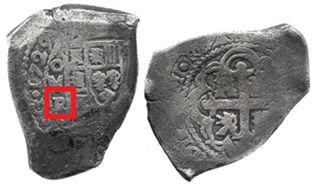 Enlarged image of a 1729 Mexican 8 Reales coin with assayer mark R for assayer José de Rivas Angulo.
Enlarged image of a 1729 Mexican 8 Reales coin with assayer mark R for assayer José de Rivas Angulo.
(Daniel Frank Sedwick, LLC, Treasure Auction #5, 9 April 2009, Lot #498.)
At the end of 1729 the Oidor and Superintendent of the Mint Don José Fernández de Veitia proceeded to provide the Attorney General (Fiscal) with a report formulating charges against the treasurer and other mint officials. But, by January 1730 the charges had yet to be formalized by the Attorney General, who insisted that with the pending departure of the fleethttp://www.todoavante.es/index.php?title=1729_-_Flota_de_Nueva_Espana. This fleet, commanded by Lieutenant General Esteban Mari, Marquis of Mari, departed the port of Cadiz, Spain on 8-9 August 1729, and arrived in Veracruz on 22, 23, 24, 27 and 28 of October of 1729. On 12 December 1729 the frigate Angustias y San Rafael, commanded by Captain Arnaud, serving as an advice vessel (navío de aviso) departed Veracruz to notify Spain of the forthcoming arrival of the fleet, arriving in Cadiz on 22 February 1730. The fleet finally departs Veracruz on 2-3 May 1730, arriving in Cadiz on 18 August 1730. which needed these coins, the imprisonment of the officials would only cause a delay in the operations of the mint, causing great damages to the merchant and the Kingdoms in general. The Attorney General requested that this trial be postponed until further notice, for which the Viceroy agreed, ordering Fernández de Veitia to continue the mintage operation.
With the fleet having departed in May 1730, Don José Fernández de Veitia now consulted with the Viceroy on 2 June 1730. The Viceroy in turn, with the Attorney General in agreement, ordered on 16 June that the guilty mint officials be arrested, being placed on house arrest (casa por cárcel). The guilty officials and the fines imposed were as followedLas Casas de Moneda… (op. cit., n. 20), p. 71.:
- Treasurer, Don José Diego de Medina Saravia, 10,000 pesos
- Assayer, Don José de Rivas Angulo, 6,000 pesos
- Weighmaster, Don Manuel Cayetano de Elizaga, 6,000 pesos
- Scribe, Don Mateo Picardo, 4,000 pesos
- Chief Guard, Don Damián Pérez Bello, 4,000 pesos
- Chief Guard, Don Juan Antonio de Urrutia, Marquis del Villar del Aguila, 4,000 pesos
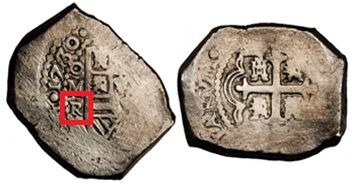
Enlarged image of a 1730 Mexican 8 Reales coin with assayer mark R for assayer José de Rivas Angulo (Recovered from the wreck of the "Rooswijk").. (Stack’s Bowers and Ponterio, January 2011 NYINC Auction Session 1, 7 January 2011, Lot #15)
By the end of June 1730, with the urgent need to fill the now vacant assayer position at the mint, the Barefoot Carmelites of the Convent of the Holy Desert were asked to name a new lieutenant. Since Diego González de la Cueva had already been named as deputy since 1727, Fray José de los Angeles, The Barefoot Carmelite Attorney General of the Province of New Spain, proceeded to name him as the new lieutenant. This appointment was accepted, but not before the judge advised Diego González de la Cueva to use the letter G of his last name, as the letter D of his first name would be easily confused with the one previously used as identifier for the Holy DesertCentro de Estudios de Historia de México (op. cit., n. 33).
As the coins attest to, Diego González de la Cueva’s tenure was extremely short (not lasting more than a few months). Although no explanation has yet been found on the documents describing the circumstances for his departure, this is most likely related to him being appointment to the post of Master Assayer and Weight Master of the Foundry of the city of Mexico (Ensayador Mayor y Balanzario de la Real Caja de México), a post which we know he was already occupying by 17 February 1731S. de Fonseca y C. de Urrutia. Historia General de Real Hacienda. Tomo I, Impresa por Vicente G. Torres, Mexico, 1845, p. 89.. With the departure of Diego González de la Cueva in 1730, Francisco de la Peña y Flores, who had been present at the mint since 1729 assisting as an interim assayer (ensayador interino), is now promoted, choosing the letter F as his identifier.
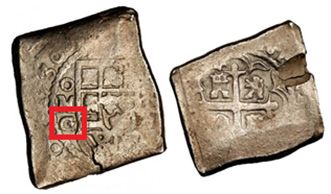
Enlarged image of a 1730 Mexican 8 Reales coin with assayer mark G for assayer Diego González de la Cueva.
(Stack’s Bowers and Ponterio, January 2011 NYINC Auction Session 1, 7 January 2011, Lot #16.)

Enlarged image of a 1730 Mexican 8 Reales coin with assayer mark F for assayer Francisco de la Peña y Flores.
(Stack’s Bowers and Ponterio, January 2011 NYINC, Auction Session 1, 7 January 2011, Lot #17).
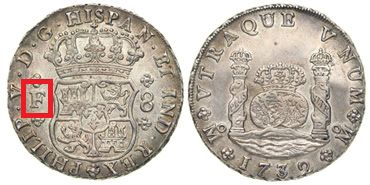
Enlarged image of a Mexican milled 8 Reales from 1732 with assayer mark F for assayer Francisco de la Peña y Flores.
(Ira & Larry Goldberg Coins and Collectibles, Sale #46: The Millennia Collection, Beverly Hills, CA, 26 May 2008, Lot #1085)
Francisco de la Peña y Flores was the assayer on record when, in 1732, the Mexico mint finally was able to mechanize the coining process and produce its first milled coinage. But in 1733, following the requirements of a new decree signed in Spain on 16 July 1730Los Códigos Españoles… (op. cit., n. 34), pp. 280-292. “Nueva Ordenanza para la labor de la moneda, su lei, i ensayes, Ministros, i Operarios de las Casas, sus obligaciones, sueldos, i derechos. El mismo en Cazalla á 16. de Julio de 1730. Cedula.” which required that two separate assayers worked the post simultaneously, Manuel de León, the son of the former assayer José de León and current mint’s accountant, under a Royal decree signed in Seville, Spain on 14 July 1732, is now moved to the post of primary assayer, with Francisco de la Peña y Floresbecoming the secondary assayer. Spain’s new appointment of Manuel de Léon as the primary proprietary numbered assayer (ensayador propietario de número)Herrera (op. cit., n. 44)., also followed the requirements of the new regulations signed in 1730 which discontinued the practice of leasing the mint offices to private parties and reverted the entire institution back to full royal control. Spain was now solely responsible for reviewing and granting all appointments to mint personnel.

Enlarged image of a 1733 Mexican Klippe (recortada) 8 reales with the marks of assayers Manuel de León (M) and Francisco de la Peña y Flores (F). (Daniel Frank Sedwick Auction #4, 6 November 2008, Lot #548).
Philip V died of a stroke in Madrid, Spain on 9 July 1746, at which time Manuel de León (assayer mark M) and Francisco de la Peña y Flores (assayer mark F) were still serving as the two proprietary (working) assayers of the Mexico mint. Philip V would be succeeded by Ferdinand, his son from his first marriage to Marie Louise of Savoy. Ferdinand started reigning upon Philip’s death, being proclaimed as Ferdinand VI, King of Spain and the Indies, on 10 August 1746J. de Pinedo y Salazar. Historia de la Insigne Órden del Toyson de Oro, dedicada al Rey Nuestro Señor, Xefe Soberano y Gran Maestre de Ella. Parte Primera, Tomo I, Imprenta Real, Madrid, 1787, p. 524..
As for the deputyship system, this was initially suspended with the execution of the royal orders that allowed for two assayers to work simultaneously at the mint. But the system would not die off. In fact, the Oidor and Mint Superintendent Don José Fernandez de Veitia, relying on his past experience with the deputyship system exercised in Mexico, proposed to the King that to prevent any delays on the mintage operation, an additional assayer should be appointed, beside the two main working assayers already mandated, so as to have someone designated to take the job for one of these assayers, or succeed him altogether, if the circumstances required it. The King approved this recommendation on 15 July 1735, appointing Francisco Herranz as the first “Supernumerary assayer” (ensayador Supernumerario) on 14 August 1736AGI: Contratación, 5483, N. 1, R. 16. In this document dated in San Ildefonso on 14 August 1736, the King tells us that his appointing of Don Francisco Herranz to the post of Supernumerary assayer (ensayador Supernumerario) at the mint of Mexico followed his approval of the recommendation made by the Mint’s Superintendent, Don José Fernández de Veitia, for this to be instituted. This document states: “Por quanto me ha Representado el Oydor don Joseph Fernandez de Veytia, Superintendente de la Casa de Moneda de la Ciudad de Mexico, q’ en cumplimiento de lo mandado en la ordenanza formada para Casas de Moneda en 16 de Jullio de 1730 -Se nombraron para la Referida Casa dos ensayadores para q’ Separadamente y por duplicado hagan los ensayes de plata y oro q’ se compran y labran de mi quenta pero q’ la experiencia avia manifestado la presission de haverse de valer de otro ensayador extraño, por ympedimiento o enfermedad de alguno de los dos, o en los casos de discordia, q’ se ofrescan, a fin de no atrasar el Curso de las labores, ni el corriente de las compras de metales, pues aun en mas ocurrencias nesesitaran los dos ensayadores valerse de otro, q’ les ayude, y q por estas Razones tenia el Superintendente por conveníente a mi Real Servicio de q’ hubiese otro ensayador Con el titulo de Supernumerario y mitad del sueldo de los propietarios, con obcion á entrar en la primera Vacante del numero Y haviendose visto en mi Junta de Comercio, y de Moneda, y consultadome sobre ese assumptto en 15-de Jullio del año próximo pasado, tube por bien de condezender con la proposission del Referido Superintendente y q’ la misma Junta me hiziese preente persona correspondiente a quien se puediese nombrar, para q’ pasase de estos Reynos a Servir el Referido empleo . en cuyo cumplimiento me ha expuesto en consulta de 25 de Septiembre del expresado año, q’ hallandose en Madrid Don Francisco Herranz de ensayador aprobado en quien concurren las circunstancias de Yntelígencia, practíco, legal, Y de toda confianza, Y de buena Vida, y Costumbres, y q’ tenía la experiencia de q’ en algunas concesiones de Vísítas de ferias, q’ avia puesto a Su cuidado, las ha desempeñado, Con todo zelo, aplicasíon, y desinterez, le proponía para el expresado empleo, Y en su Yntelígencia he Resuelto elegir y nombrar (como por la presente elijo,y nombro) a don francisco Herranz por ensayador Supernumerarío de mi Casa de Moneda de la Ciudad de Mexico con el sueldo de mill y quinientos pesos al año y obzion a la Vacante de uno de los dos ensayadores del numero de la misma casa, Y el goze de este Sueldo desde el dia, q’ justificare haverse envarcado en Cadiz para parsar a el Reyno de la Nueva Spaña . a Servir el Referido empleo…”. Although Herranz did travel to Mexico in 1736 in fulfillment of his appoint, he would never serve as an assayer on record at the Mexico mint, as he died in 1745 while still awaiting the opportunity to assume one of the two primary assayer positions.
With Herranz’s death, the post would be temporarily occupied by José de Rivas Angulo (not to be confused with the earlier assayer of the same name), who was named as interim assayer by the Viceroy, while the King could make his own appointment. This appointment would ultimately go to Manuel de Asorín, appointed by the King on 19 October 1745. Manuel de Asorín traveled to Mexico at the end of 1746AGI: Contratación, 5488, N. 1, R. 22. and would eventually become an assayer on record in 1754, when being promoted on that year, following the death of Francisco de la Peña y Flores.
New, updated list of the Mexican assayers during the Reign of Philip V (1700-1746)
| Initial(s) | Name(s) | Began on | Left office on |
| L | Manuel de León | 1677 | 1705 |
| J | José de León | 1705 | 1723 |
| D | El Santo Desierto (with José de Rivas Angulo as their working assayer) | 1724 | 1729 |
| R | José de Rivas Angulo | 1729 | 1730 |
| G | Diego González de la Cueva | 1730 | 1730 |
| F | Francisco de la Peña y Flores | 1730 | 1733 |
| FM | Manuel de León Francisco de la Peña y Flores |
1733 | 1754 |
